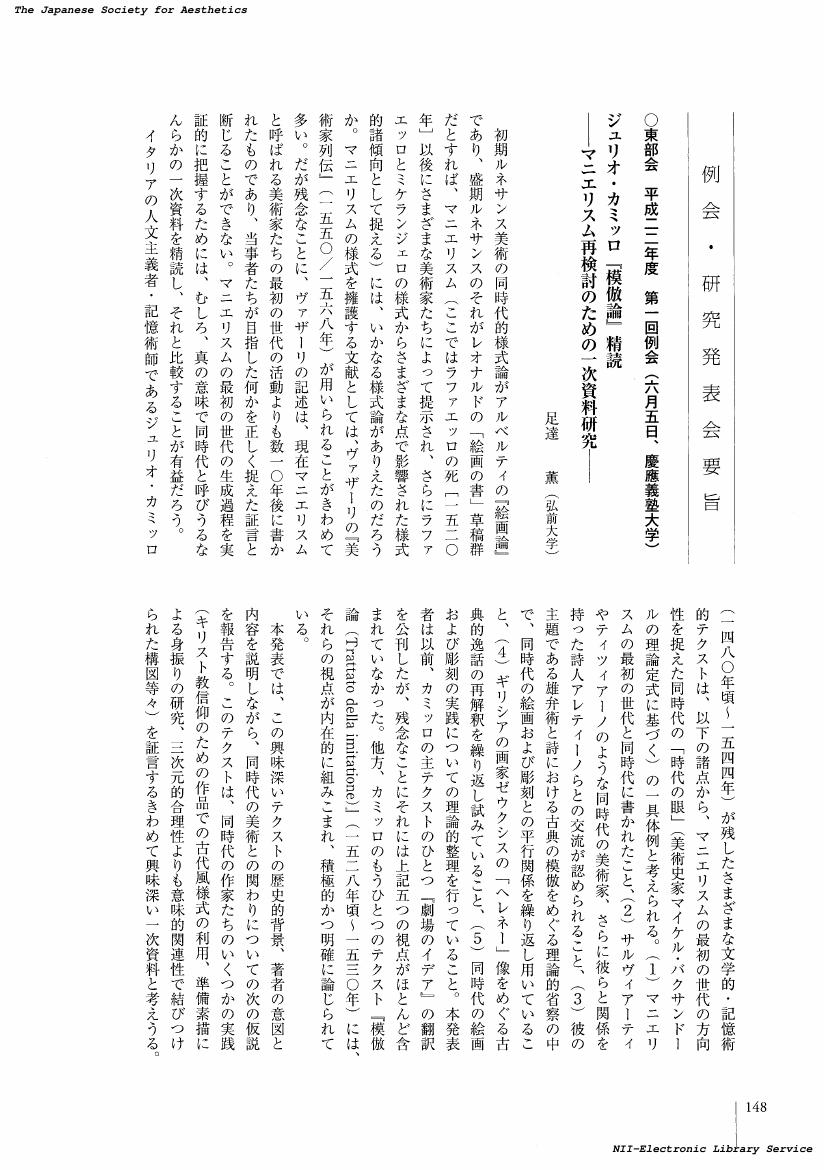- 著者
- 茅根 紀子
- 出版者
- 美学会
- 雑誌
- 美学 (ISSN:05200962)
- 巻号頁・発行日
- vol.61, no.2, pp.143, 2010-12-31 (Released:2017-05-22)
- 著者
- 足達 薫
- 出版者
- 美学会
- 雑誌
- 美学 (ISSN:05200962)
- 巻号頁・発行日
- vol.61, no.2, pp.148, 2010-12-31 (Released:2017-05-22)
- 著者
- 中川 航
- 出版者
- 美学会
- 雑誌
- 美学 (ISSN:05200962)
- 巻号頁・発行日
- vol.61, no.2, pp.128, 2010-12-31 (Released:2017-05-22)
- 著者
- 唄 邦弘
- 出版者
- 美学会
- 雑誌
- 美学 (ISSN:05200962)
- 巻号頁・発行日
- vol.61, no.2, pp.129, 2010-12-31 (Released:2017-05-22)
- 著者
- 林田 新
- 出版者
- 美学会
- 雑誌
- 美学 (ISSN:05200962)
- 巻号頁・発行日
- vol.61, no.2, pp.130, 2010-12-31 (Released:2017-05-22)
- 著者
- 福地 勝美
- 出版者
- 美学会
- 雑誌
- 美学 (ISSN:05200962)
- 巻号頁・発行日
- vol.61, no.2, pp.132, 2010-12-31 (Released:2017-05-22)
1 0 0 0 OA 社会を味わう : 商店街を例とした社会美学の試み(第六十一回美学会全国大会発表要旨)
- 著者
- 藤阪 新吾
- 出版者
- 美学会
- 雑誌
- 美学 (ISSN:05200962)
- 巻号頁・発行日
- vol.61, no.2, pp.133, 2010-12-31 (Released:2017-05-22)
- 著者
- 道廣 真衣
- 出版者
- 美学会
- 雑誌
- 美学 (ISSN:05200962)
- 巻号頁・発行日
- vol.61, no.2, pp.134, 2010-12-31 (Released:2017-05-22)
1 0 0 0 OA 諸感覚の交差点としての嗅覚(第六十一回美学会全国大会発表要旨)
- 著者
- 宮崎 薫
- 出版者
- 美学会
- 雑誌
- 美学 (ISSN:05200962)
- 巻号頁・発行日
- vol.61, no.2, pp.135, 2010-12-31 (Released:2017-05-22)
- 著者
- 甲斐 義明
- 出版者
- 美学会
- 雑誌
- 美学 (ISSN:05200962)
- 巻号頁・発行日
- vol.61, no.2, pp.119, 2010-12-31 (Released:2017-05-22)
- 著者
- 河上 眞理
- 出版者
- 美学会
- 雑誌
- 美学 (ISSN:05200962)
- 巻号頁・発行日
- vol.61, no.2, pp.120, 2010-12-31 (Released:2017-05-22)
- 著者
- 桑原 夏子
- 出版者
- 美学会
- 雑誌
- 美学 (ISSN:05200962)
- 巻号頁・発行日
- vol.61, no.2, pp.121, 2010-12-31 (Released:2017-05-22)
- 著者
- 郡田 尚子
- 出版者
- 美学会
- 雑誌
- 美学 (ISSN:05200962)
- 巻号頁・発行日
- vol.61, no.2, pp.122, 2010-12-31 (Released:2017-05-22)
- 著者
- 調 文明
- 出版者
- 美学会
- 雑誌
- 美学 (ISSN:05200962)
- 巻号頁・発行日
- vol.61, no.2, pp.123, 2010-12-31 (Released:2017-05-22)
1 0 0 0 OA 聖史劇の演出と受容 : 『聖霊降臨祭』を中心に(第六十一回美学会全国大会発表要旨)
- 著者
- 杉山 博昭
- 出版者
- 美学会
- 雑誌
- 美学 (ISSN:05200962)
- 巻号頁・発行日
- vol.61, no.2, pp.124, 2010-12-31 (Released:2017-05-22)
- 著者
- 千 宗員
- 出版者
- 美学会
- 雑誌
- 美学 (ISSN:05200962)
- 巻号頁・発行日
- vol.61, no.2, pp.125, 2010-12-31 (Released:2017-05-22)
- 著者
- 寺本 圭佑
- 出版者
- 美学会
- 雑誌
- 美学 (ISSN:05200962)
- 巻号頁・発行日
- vol.61, no.2, pp.127, 2010-12-31 (Released:2017-05-22)
1 0 0 0 OA H・P・ロビンソンの写真論における想像力の問題
- 著者
- 調 文明
- 出版者
- 美学会
- 雑誌
- 美学 (ISSN:05200962)
- 巻号頁・発行日
- vol.61, no.2, pp.85-96, 2010-12-31 (Released:2017-05-22)
This paper aims to consider how photography can incorporate "imagination" in itself despite the fact that it is limited to representing something in front of a camera. For this consideration, the nineteenth-century British photographer H. P. Robinson is the key figure, because he continued to think the relationship between photography and imagination throughout his photographing career. In Pictorial Effect in Photography (1869), he regarded imagination as faculty for composing something that did not exist, for example, angels. He insisted, therefore, that a photographer violated fitness as a picture-maker when he depended on imagination. But in The Art and Practice of Silver Printing (1881), Robinson focused on a photographer as a picture-viewer and turned to look upon imagination as faculty for forming a picture of something as it should be. Moreover, Robinson implied in Picture Making by Photography (1884) that when the photographer's imagination was stimulated by something instantaneous that was fixable only by gelatin plate, he might try to set up an event in the real world as it looked instantaneous and to photograph it. In my reading, Robinson believed such an operation of imagination enabled the photographer to demonstrate his imagination without violating fitness.
- 著者
- 新井 思郎
- 出版者
- 美学会
- 雑誌
- 美学 (ISSN:05200962)
- 巻号頁・発行日
- vol.61, no.2, pp.114, 2010-12-31 (Released:2017-05-22)
- 著者
- 石田 圭子
- 出版者
- 美学会
- 雑誌
- 美学 (ISSN:05200962)
- 巻号頁・発行日
- vol.61, no.2, pp.115, 2010-12-31 (Released:2017-05-22)


















